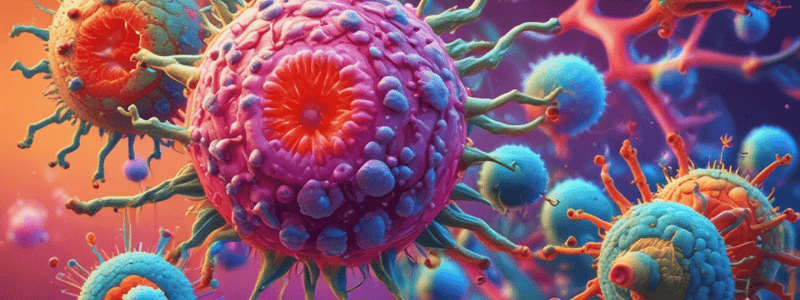Podcast
Questions and Answers
Which characteristic distinguishes viruses from cellular pathogens?
Which characteristic distinguishes viruses from cellular pathogens?
- Viruses possess both DNA and RNA, while cellular pathogens have only one type of genetic material.
- Viruses are visible under a light microscope, while cellular pathogens are not.
- Viruses can metabolize and reproduce on their own, while cellular pathogens require a host. (correct)
- Viruses are intracellular parasites, while cellular pathogens can exist independently.
What is the highest level of virus classification, but is rarely used?
What is the highest level of virus classification, but is rarely used?
- Family
- Order (correct)
- Species
- Genus
What is the typical size range of a virus particle?
What is the typical size range of a virus particle?
- 100-400 nanometers
- 10-100 nanometers
- 400-1000 nanometers
- 10-400 nanometers (correct)
Which of the following is a common characteristic of viral genetic material?
Which of the following is a common characteristic of viral genetic material?
What is the key difference between the structure of viruses and cellular pathogens?
What is the key difference between the structure of viruses and cellular pathogens?
What is the most likely origin of viruses according to the text?
What is the most likely origin of viruses according to the text?
In terms of numbers, how abundant are viruses on Earth compared to other organisms?
In terms of numbers, how abundant are viruses on Earth compared to other organisms?
What is the approximate number of human-infecting viruses discovered as of 2012?
What is the approximate number of human-infecting viruses discovered as of 2012?
What is the primary lifestyle strategy of viruses according to the text?
What is the primary lifestyle strategy of viruses according to the text?
In theory, how many genes would the 'simplest' virus have?
In theory, how many genes would the 'simplest' virus have?
What factor contributes significantly to the diversity of viral pathogens?
What factor contributes significantly to the diversity of viral pathogens?
What is the main difference between Permissive and Non-Permissive in terms of viral replication?
What is the main difference between Permissive and Non-Permissive in terms of viral replication?
Which phase of viral replication involves capsid rearrangement?
Which phase of viral replication involves capsid rearrangement?
In the context of viral replication, what is viral tropism?
In the context of viral replication, what is viral tropism?
What distinguishes Enveloped viruses from Naked viruses in terms of release during viral replication?
What distinguishes Enveloped viruses from Naked viruses in terms of release during viral replication?
Which Baltimore Class involves Reverse Transcription from RNA to DNA?
Which Baltimore Class involves Reverse Transcription from RNA to DNA?
Which drug category is specifically mentioned for targeting HIV, Herpes viruses, HBV, and HCV during the Synthesis phase of viral replication?
Which drug category is specifically mentioned for targeting HIV, Herpes viruses, HBV, and HCV during the Synthesis phase of viral replication?
Which method is used to identify virus particles by morphology?
Which method is used to identify virus particles by morphology?
Which diagnostic method involves breaking apart double-stranded DNA?
Which diagnostic method involves breaking apart double-stranded DNA?
What is the error rate in DNA viruses due to polymerase proofreading?
What is the error rate in DNA viruses due to polymerase proofreading?
Which method detects the presence of viral nucleic acid?
Which method detects the presence of viral nucleic acid?
What distinguishes the Serology Method from other diagnostic methods?
What distinguishes the Serology Method from other diagnostic methods?
What is a characteristic of RNA viruses in terms of polymerase proofreading?
What is a characteristic of RNA viruses in terms of polymerase proofreading?
Flashcards are hidden until you start studying




